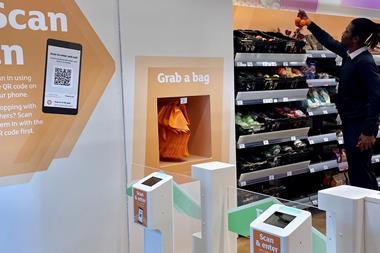Analysis by Jon Woolven
Wal-Mart's entry to the UK has forced its competitor multiples to reassess their supply chain strategies radically.
Sainsbury supply chain director Martin White sums it up: "For the first time, there's now clear blue water between the leading retailers."
In other words, each retailer has distinct ambitions and these are reflected in varying supply chain priorities.
Asda's chief aim is to deliver a low cost infrastructure to support its every day low price strategy. As it approaches the end of an intensive 12-month conversion programme, it's confident that Wal-Mart's information systems will deliver substantial cost savings.
Previously lagging behind its main competitors in the use of IT, Asda expects to leapfrog to the leading edge.
Wal-Mart's expertise in general merchandise categories will also help Asda to improve its non-grocery logistics.
Safeway's chief priority is flexibility. With a policy of greater independence for store managers, deep cut promotions in regional clusters and a pledge of 100% on shelf availability for 1000 key lines, it requires an adaptable and responsive chain that is also ultra-reliable.
Supply director Lawrence Christensen has been leading the changes. "Safeway's operations are very different to this time last year. For instance, our promotions have stimulated up to five years' worth of sales in a week for some products in some stores and that's forced us to introduce some entirely new processes.
"We may have to increase our inventories a little in future to meet our service targets, but we can offset that with more efficient transport," says Christensen.
With increasing fuel prices, driver costs and road congestion, the transport element of logistics costs is rising sharply.
IGD's survey shows a major shift in the breakdown of retailer logistics costs over the last 12 months.
Safeway is improving its transport efficiency through increased back-hauling and also via satellite tracking systems to help vehicles better navigate through congestion and to monitor and improve fuel consumption. Christensen further believes that the rail network has a growing role for trunking goods over long distances, particularly from overseas.
Sainsbury, like Safeway, is developing its fresh food range but has a major constraint to overcome.
As a frontrunner in opening regional depots in the 1980s, the design of many of its warehouses is now outdated. Relatively narrow and tall, they're built for storing ambient goods, rather than rapidly marshalling perishable products for immediate delivery to store.
"We have to fix our supply chain, by missing out the bit in the middle," says White.So the multiple is committing to consolidation centres where several suppliers combine loads into store-ready deliveries.
"This simplifies operations, helping Sainsbury to get the most from its limited floorspace.
In contrast, Tesco is rapidly opening new stores. It aims to service this growing portfolio without expensive new warehouses, putting its efforts into increasing space productivity through just-in-time logistics. Supported by the Lean Enterprise experts at Cardiff Business School, Tesco is using a technique called value chain analysis to map operations and eliminate idle-time. It estimates this will save £150m through greater efficiency and lower inventories in the current year.
Tesco's target is to reduce the standard order lead-time from RDC to its large stores from 24 to 8 hours. Three deliveries per day will help it re-merchandise parts of the store for the different needs of morning, afternoon and evening customers. Most importantly, it enables fewer facings per item and therefore a bigger range in each store.
If the leading retailers each have distinctly different priorities, this potentially creates a major headache for their suppliers.
Procter & Gamble logistics director Chris Poole prefers to see it as an opportunity. "It's vital for manufacturers to recognise the competitive battle within retailing.
"We need to respond by developing truly customer-centric logistics. That way, we can turn logistics from a drag on the business to a way of building competitive edge."
The solution lies in two parts: flexible operations and better information flow. Inflexible production lines that waste hours when switching from one product line to another are a major hindrance in the current environment. Techniques such as single minute exchange of dies (SMED) can help manufacturers cut back changeover times and produce smaller batch sizes economically.
Manufacturers with several factory locations are also marshalling their internal distribution facilities more effectively. Procter & Gamble is consolidating its diverse finished goods range into a single service centre. This will allow it to provide customer specific services, such as store-ready mixed product cases.
The new net consortia, such as the GlobalNetXchange, World-wide Retail Exchange and Transora, are the key to improving information flow. UK retailers have already developed in house net based collaborative systems such as Tesco's TIE and Sainsbury's SID, but by forming international alliances they can develop new state of the art services much more quickly.
Tesco supply chain research and development director Neil Sachdev says: "WWRE will bring us four main benefits: scale, consistency, speed and expertise.
"The exchange will force decisions to happen more quickly."
The consortia are often called trading exchanges' but online trading is just one of their functions. Retailers insist their main use is to enhance long-term relationships.
In particular, each exchange is adding the functionality for collaborative planning, forecasting and replenishment (CPFR). This is a methodology, developed by VICS in the US, to help manufacturers and retailers share and jointly develop sales plans, forecasts and orders.
If CPFR can provide suppliers with advanced warning of requirements, they will be much better able to plan their operations efficiently yet meet the contrasting needs of every customer.
"If we're completely successful, there'll be no sudden surprises in our trading relationships," says Sachdev.
Sainsbury, too, is launching a series of CPFR pilot studies via GNX.
Certainly the challenges ahead are bringing creative thinkers to the fore. "We've only scratched the surface of what's possible so far. The biggest changes are certainly yet to come," says Safeway's Christensen.
- Jon Woolven is director of research and new developments, IGD
{{FOCUS SPECIALS }}
Close menu
- Home
- Retail & Wholesale
-
Products & Suppliers
- Back to parent navigation item
- Products & Suppliers
-
Product Categories:
- Back to parent navigation item
- Product Categories:
- Alcoholic drinks
- Bakery
- Cereals & breakfast
- Cheese
- Chicken & poultry
- Chocolate
- Confectionery
- Crisps, nuts & snacks
- Dairy
- Fish
- Fresh produce
- Frozen
- Household
- Meat
- Own Label
- Sauces & condiments
- Seasonal
- Soft drinks
- Vaping
- Vegan & plant-based
- World foods
- Suppliers
- People
- Reports & Data
-
Topics A-Z
- Back to parent navigation item
- Topics A-Z
-
Popular topics:
- Back to parent navigation item
- Popular topics:
- Cost of living crisis
- Crime
- Deposit Return Schemes
- Finance
- Government & Regulation
- Health
- Inflation
- Loyalty
- Marketing
- Mergers & Acquisitions
- New Product Development
- Sourcing
- Supply chain
- Sustainability & environment
- Technology
- Ultra Processed Foods
- Vaping
- A-Z all topics
- Content by type:
- Events
- Subscribe now
Sign in to comment on this article
Not logged in before? Register for FREE guest access today.
You will be able to:
- Read more stories
- Receive daily newsletters
- Comment on stories
Advert

















No comments yet